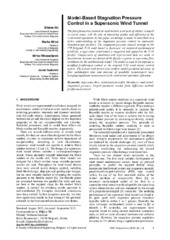Приказ основних података о документу
Upravljanje zaustavnim pritiskom u supersoničnim aerotunelima zasnovano na modelu
Model-based stagnation pressure control in a supersonic wind tunnel
| dc.creator | Ilić, Biljana | |
| dc.creator | Miloš, Marko | |
| dc.creator | Milosavljević, Mirko | |
| dc.creator | Isaković, Jovan | |
| dc.date.accessioned | 2022-09-19T17:56:21Z | |
| dc.date.available | 2022-09-19T17:56:21Z | |
| dc.date.issued | 2016 | |
| dc.identifier.issn | 1451-2092 | |
| dc.identifier.uri | https://machinery.mas.bg.ac.rs/handle/123456789/2362 | |
| dc.description.abstract | Upravljanje parametrima strujanja u aerotunelima je oblast intenzivnog istraživanja poslednjih godina, sa ciljem poboljšanja kvaliteta i efikasnosti rada aerotunelskih instalacija. Ovaj rad predstavlja pokušaj da se doprinese boljem razumevanju upravljanja zaustavnim pritiskom u supersoničnim instalacijama prekidnog dejstva. Razmotrena je strategija upravljanja zaustavnim pritiskom u aerotunelu T-38 Vojnotehničkog instituta u Beogradu. Poboljšani matematički model supersoničnih aerotunelskih instalacija je predložen i primenjen na aerotunel T-38. Tačnost sa kojom matematički model predviđa odziv instalacije u uslovima supersoničnog strujanja demonstrirana je poređenjem podataka iz simulacija i eksperimenata. Matematički model je upotrebljen za uvođenje izmenjenog algoritma upravljanja u polazni upravljački sistem aerotunela T-38. Aerotunelski eksperimenti su potvrdili predviđanja modela u pogledu smanjenja vremena uspostavljanja strujanja i povećanja raspoloživog vremena za merenje, čime je postignuto značajno poboljšanje efikasnosti rada aerotunela. | sr |
| dc.description.abstract | The flow parameters control in wind tunnels is an area of intense research in recent years, with the aim of improving quality and efficiency of the wind tunnel operation. In this paper, an attempt is made to contribute to a better understanding of the stagnation pressure control in supersonic blowdown-type facilities. The stagnation pressure control strategy in the VTI Belgrade T-38 wind tunnel is discussed. An improved mathematical model for a supersonic wind tunnel is suggested and applied to the T-38 facility. Comparisons of simulation and experimental data are made to demonstrate accurate prediction of the facility response in supersonic flow conditions by the mathematical model. The model is used to incorporate a modified feedforward control in the original T-38 wind tunnel control system. The actual wind tunnel tests confirm model-predicted decrease of flow stabilization time and increase of available measurement time, bringing significant improvement in the wind tunnel operation efficiency. | en |
| dc.publisher | Univerzitet u Beogradu - Mašinski fakultet, Beograd | |
| dc.rights | openAccess | |
| dc.rights.uri | https://creativecommons.org/licenses/by/4.0/ | |
| dc.source | FME Transactions | |
| dc.subject | supersonic flow | en |
| dc.subject | stagnation pressure | en |
| dc.subject | mathematical model | en |
| dc.subject | lumped parameter model | en |
| dc.subject | finite difference method | en |
| dc.subject | feedforward control | en |
| dc.subject | blowdown wind tunnel | en |
| dc.title | Upravljanje zaustavnim pritiskom u supersoničnim aerotunelima zasnovano na modelu | sr |
| dc.title | Model-based stagnation pressure control in a supersonic wind tunnel | en |
| dc.type | article | |
| dc.rights.license | BY | |
| dc.citation.epage | 9 | |
| dc.citation.issue | 1 | |
| dc.citation.other | 44(1): 1-9 | |
| dc.citation.rank | M24 | |
| dc.citation.spage | 1 | |
| dc.citation.volume | 44 | |
| dc.identifier.doi | 10.5937/fmet1601001I | |
| dc.identifier.fulltext | http://machinery.mas.bg.ac.rs/bitstream/id/1103/2359.pdf | |
| dc.identifier.scopus | 2-s2.0-84976876679 | |
| dc.type.version | publishedVersion |


